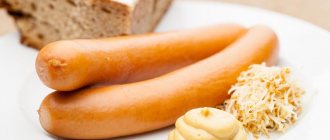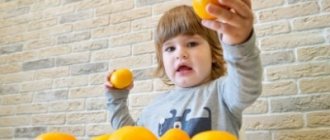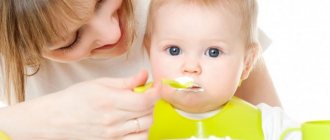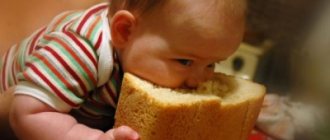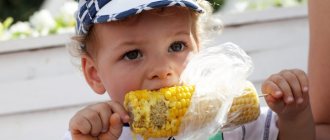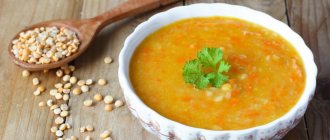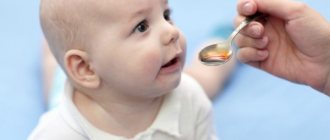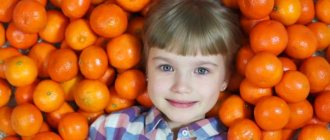Everyone knows peas primarily as “musical porridge,” but this biased name in no way detracts from all the beneficial properties of this legume dish. At what age can it be introduced into a child’s diet? We'll talk about all this in more detail below.
Peas are a valuable product because their composition is very rich. For example, many people know that peas are the champion in vegetable protein content; indeed, they contain almost twice as much protein as wheat. In addition, peas are very nutritious and high in calories, so much so that they surpass beef in this indicator, and they contain more starch than potatoes. Pea porridge is also a source of iron and calcium.
It must be said that green peas (fresh) contain more vitamins A, PP, B and C. And the selenium it contains is a powerful antioxidant that fights free radicals. Pea fiber helps remove toxins from the body and improves intestinal motility. Hence the “musicality”
Can a child have pea soup: the benefits and harms of peas in a child’s diet
The main component of pea soup is the peas themselves (fresh, dry or canned).
All members of the legume family are good sources of protein. Moreover, the protein obtained from these plants is considered complete in its composition, containing all the essential amino acids so necessary for the child’s body for successful growth and development. Another advantage is the hypoallergenic nature of the vegetable protein consumed. This makes it possible to expand the diet of children susceptible to allergies without the risk of negative reactions from the immune system.
Peas are an easily accessible source of vitamins and microelements. Such as, for example, ascorbic and folic acids, B vitamins, calcium, phosphorus and iodine. This composition of the product stimulates the development and functioning of the nervous system, in particular the brain. There is a positive effect on the hematopoietic system. The risk of developing anemia is reduced.
But do not forget about the negative sides of peas. Legumes are considered difficult to digest foods. To digest peas in any form of preparation, the body needs to expend a large amount of energy. At the same time, all enzyme systems of the stomach, intestines and digestive glands, as a rule, the pancreas, enter a state of intense work.
Peas cause increased gas formation and increased intestinal motility. This can cause colic and pain in the baby's abdomen. There is no accurate evidence that peas can cause diarrhea in a child. Everything is individual. One child may experience loose stool after eating peas, while another may experience constipation.
Can it be in a child’s diet?
Peas are not the main component of complementary foods in early childhood. The baby’s digestive system is not yet able to cope with a heavy high-calorie product. But there are no categorical prohibitions on eating pea soup.
At what age should it be included in complementary foods/food?
Some parents practice early introduction of pea complementary foods into their babies' food - from 9-10 months. This is advisable only in cases where the child tolerated peas well in maternal nutrition and is familiar with other children's dishes - cereals, juices and purees.
In other cases, it is recommended to introduce pea soup into complementary foods only in the second year of a child’s life. And soups with legumes prepared according to the classic recipe can be included in food no earlier than 4-5 years. Most pediatricians are of the opinion that the ideal age for introducing a baby to pea soup is 2 years.
Peas in children's soup should be pureed or boiled; you cannot feed your child whole peas.
A young mother should note that the first portions of soup should not exceed 2 tablespoons. And to make it easier for the stomach to cope with legumes, it is first advised to eat a small portion of a savory second course (porridge, mashed potatoes, cottage cheese). To diversify the diet, it will be enough to give pea soup once every 2-3 days.
How is it useful?
Peas are a real storehouse of protein, vitamins and minerals, which, if consumed correctly, will only benefit the baby’s growing body. What are the benefits of peas for a child:
- promotes the full development of the central nervous system;
- replenishes the body's energy reserves;
- relieves the baby from excessive nervousness and capriciousness;
- serves as a prevention of anemia and accelerates the production of hemoglobin;
- has a beneficial effect on the heart and blood vessels;
- serves as the basis for cell growth and development.
The product contains a large amount of selenium, which prevents the development of cancer. And calcium in legumes contributes to the formation of a strong skeleton and healthy teeth.
Complementary food in the form of pea soup
There is no consensus on the age at which pea soup, porridge or puree can be included in a child’s diet. Pediatricians categorically prohibit feeding babies under one year old with such food. However, some mothers offer peas to their babies at an earlier age, for example, at 9-10 months. This is acceptable if the baby has already mastered other types of complementary foods and tolerates food well.
It is worth keeping in mind that a 6-month-old baby should not be fed peas or dishes based on them at all. Ideally, if acquaintance with a new type of food takes place after a two-year period. Pea soup prepared according to the classic recipe can be offered to children after reaching the age of 4-5 years.
When introducing legume complementary foods, several rules should be followed:
- Start giving your baby pea soup preferably in the first half of the day;
- initial portions should not exceed 2 tablespoons in volume;
- You should not start your meal right away with peas; it will be difficult for the child’s digestive tract to process such food;
- you need to gradually increase the amount of food, eventually bringing its volume to a full portion;
- It is imperative to carefully monitor the body’s reaction; if you notice that the baby’s gas formation has increased, you should slightly reduce the daily portion of soup;
- peas for the first feeding should be chopped with a fork or blender, that is, you get a puree soup;
- the frequency of consumption of legume soup should not exceed once every 2-3 days;
- On the same day as peas, you should not give your baby nuts, sausages, fish or natural juices.
Pea soup for babies should be cooked only in vegetable broth, and classic soup with smoked meats can only be given after four years.
Are boiled peas harmful during lactation?
The uniqueness of boiled peas lies in the fact that during heat treatment the beneficial substances remain in them almost completely. In terms of nutritional value, it competes with buckwheat and rice. When boiled, it is an excellent supplier of carbohydrates - a storehouse of energy for humans.
It is very important for a nursing mother to receive vitality from healthy sources.
Peas do not cause colic in a baby, so a nursing mother can eat them calmly without worrying about the baby
There is an opinion that peas can cause colic in a baby. We hasten to assure you that it is erroneous. The mechanism of the appearance of colic in infants has not yet been clarified, and the reason for it clearly lies deeper than the food preferences of the nursing mother. Increased flatulence is also very unlikely in a child. A slight increase in gas formation may occur in a nursing woman. It is so insignificant that you should not give up eating legumes, given the colossal supply of nutrients that the mother’s body will receive.
The second most common concern is food allergies. It is extremely rare on peas in infants. However, it should be introduced gradually, like any other product into the diet during lactation, carefully monitoring the child’s reaction.
At what age should children be given pea soup?
Peas are a representative of the legume crop, which is the most common and popular in modern cooking. This product is not only dietary, but also includes a huge amount of useful substances that are not lost during cooking.
As a result, caring parents wonder at what age they can include peas in a child’s diet. Of course, when we talk about baby food, the first thing that comes to mind is puree, but pea soup is much tastier and healthier. This is the dish that should be given to the child first, as soon as the right time comes.
Features of pea soup. When can you include a dish on a children's menu?
The main advantage of pea soup is its significant positive effect on the child’s entire nervous system and the brain itself.
By including this dish in your diet, you can significantly improve the speed and quality of development of many features of the child’s body. An equally important advantage is the presence of a large amount of protein in peas.
Despite the fact that the product is dietary, it provokes increased gas production, so carefully calculate the portions before including soup on your child’s menu.
Follow two main rules:
Statistics show that the best age to include pea soup in the diet of children is 1-2 years.
At this time, peas cannot harm the baby, having only a positive effect on the body. In principle, you can slowly start giving the dish one or two spoons, even to a one-year-old child. At this age, you can easily determine whether your baby likes this type of food.
You need to start feeding yourself full-fledged pea soup slowly, no matter how old you were when you started doing it. Carefully study your baby's reaction to soup. We are talking not only about the physical reaction, but also about subsequent processes inside the body.
If gas formation increases after such a dish, it may be worth reducing the portion, or even postponing the introduction of the soup for a few more months.
From the personal experience of many young mothers, it follows that in most cases, babies over 12 months of age perfectly perceive such a dish in every sense.
Principles for making baby pea soup
It is not only possible, but also necessary to give pea soup to children at such an early age for the reasons listed above.
The problem is that in modern cooking there are a huge number of recipes for preparing such a dish, most of which are not suitable for baby food.
The fact is that such soups use products that are not recommended for consumption by children.
To prepare the right baby soup, use the following recommendations:
1. Experts recommend using vegetable broth for cooking.
3. Peas must be prepared in advance, since this recipe calls for quick boiling. To do this, soak it in cold water and leave for 10-12 hours.
4. For cooking we use basic products without unnecessary spices and so on. Peas, carrots, potatoes and onions are the perfect set. It is in this order that the products should be immersed in boiling water.
5. For the first feedings, it is recommended to turn the soup into puree, chopping the finished product with a regular fork. This consistency will make it easier to feed the baby, and will also be absorbed into the body much faster.
Use fresh frozen peas to make the dish more dietary and healthier.
What ingredients are prohibited?
Oddly enough, most products from classic recipes cannot be used for baby food:
- Smoked meats are the first thing to be excluded, despite the fact that traditional soup is prepared with just such an additive.
- Fatty meat - as indicated, the broth is prepared using low-fat soft pieces.
- Spices - salt is enough to make the dish tasty. The aroma and specific taste will be provided by the products themselves.
- Bouillon cubes are something you need to get rid of altogether. Never use chemical additives in baby food.
So, pea soup can be given to a child at a fairly early age. If you want to simplify your task and not cook the dish separately, simply dilute the soup prepared for the whole family with vegetable broth in a 1:1 ratio.
Recommendations and tips for preparation and introduction into the diet
- The vegetable protein contained in peas is difficult to digest by the body. Pea porridge is not suitable for very young children. In addition, stimulating peristalsis is also not always beneficial for the imperfect digestive system of young children.
- These factors determine the introduction of pea porridge at the age of 3 years.
Peas are a hypoallergenic product and rarely cause allergic reactions. But still, the first portion of pea porridge should not exceed 1-2 teaspoons. If you have not noticed any manifestations of allergies in the form of rashes and redness of the skin, and the child’s stool and mood are fine, then the portion of porridge can be increased.
- To make your porridge tasty and for your baby to eat it with pleasure, you must first soak the peas in cold water. The minimum soaking time is 4 hours, but it is better to cover the peas with water and leave overnight. Rinse the peas before soaking. Keep in mind that it will swell in water - take a larger container, place the washed peas in it and fill it with water. There should be 3 times more water than peas. For example, 1 glass of peas is filled with 3 glasses of clean drinking water.
- Before cooking, the water in which the peas were soaked is drained and the peas are washed again.
- To prepare delicious pea porridge, vegetables are added to it. Usually these are onions, bell peppers and carrots.
- A small amount of cream will make the porridge taste more delicate and give it a light milky aroma.
- The secret of an exemplary pea porridge is in maintaining the proportions. To make the porridge “like in kindergarten,” when cooking, add one part of the peas to two parts of water. Also, the taste of the porridge depends on the degree of boiling of the peas, that is, on how long to cook the pea porridge. On average, porridge is cooked over low heat for about 40 minutes.
Beneficial features
Peas are an excellent source of plant protein, like other legumes. Proteins are the most important components of any balanced diet. They are necessary for building new cells in the body. A child's body needs protein daily to meet its physiological needs. If for some reason a child receives an insufficient amount of proteins, this can lead to the baby growing worse, and in some cases even lagging behind in his physical development.
To avoid such undesirable consequences, pediatricians recommend that parents of babies be sure to include a sufficient amount of protein-containing foods in the diet of their babies. Moreover, for the full functioning of the body, the child must receive both proteins of plant and animal origin. This is necessary so that the actively growing child’s body receives all the essential amino acids necessary for its growth - substances that are a kind of “building blocks” for the structure of new cells.
As a rule, there are no problems with animal protein. It often happens in practice that a child receives an insufficient amount of vegetable protein.
You can fill the body's physiological need for this important nutrient with regular peas. Both fresh and dry peas contain many vegetable proteins that a growing baby needs
Peas have a unique chemical composition. It contains a number of minerals and vitamins important for the body:
- calcium;
- folic acid;
- phosphorus;
- sodium;
- selenium.
It is believed that the systematic inclusion of dishes including peas in a baby’s diet is a good prevention of the development of an anemic condition. If anemia is severe, it can lead to a delay in physical development of the child. Including pea dishes in children's menus is one of the excellent preventive measures that helps improve blood counts. Peas also contain dietary fiber. These components have a positive effect on the functioning of the large intestine. Eating dishes made from peas helps normalize stool.
However, it should be remembered that they can lead to excessive gas formation in the intestines and flatulence. Typically, symptoms that cause discomfort develop after eating a fairly large portion of pea porridge. If, every time after eating a pea dish, the baby develops a feeling of severe bloating in the abdomen and even pain, then his parents should definitely consult a pediatrician about this.
LiveInternetLiveInternet
Quote from BelanaD
Read in full In your quotation book or community!
Pea porridge is one of those dishes that many people have known since childhood. Healthy and at the same time very tasty, for many children it is one of the favorite porridges, however, adults also eat it eagerly, especially if you add tasty additions to it.
Peas are very healthy: they contain a lot of vitamins A, B and C, microelements (calcium, iron, etc.), easily digestible proteins, antioxidants and amino acids. It is not without reason that peas were one of the most important products for our ancestors, and not only porridges were prepared from them, but also soups, jelly, and even pies. Today, unfortunately, peas are not so popular, but anyone who watches their figure and wants to be healthy should definitely introduce pea dishes into their weekly diet.
It is recommended to eat peas for heartburn, constipation, high blood sugar and various digestive problems.
Pea porridge is a tasty, satisfying, nutritious dish that is almost impossible to spoil. However, in order for such porridge to turn out to be truly healthy and tasty, you need to observe some subtleties when preparing it. So, let's look at the steps involved in preparing real pea porridge.
Preparing the peas
First of all, it’s worth talking about which peas are best to choose for cooking the healthiest porridge. The most valuable in terms of the content of various vitamins and nutrients are unshelled peas, but such peas must be pre-soaked in water.
First, you need to sort out the peas, removing spoiled and low-quality peas, then rinse them under running water several times and pour them into a saucepan (it’s better to use a cast iron or Teflon-coated pan), add water at the rate of 1 part peas to 4 parts water and leave for 5-7 hours or overnight. Soaking peas in water ensures their rapid boiling, i.e. Thanks to this, the porridge will turn out puree.
Here, in general, are all the subtleties of the preliminary stage, then we proceed to the most interesting thing - cooking the porridge.
Secrets of proper cooking of pea porridge
You need to put the peas on the stove to cook in the same water in which they were soaked. The container in which the porridge will be cooked must be thick-bottomed and thick-walled - then the peas will be cooked evenly.
Place the pan over medium or low heat and bring to a boil; after boiling, the porridge can be salted, stirred, and the heat on the stove should be reduced and then cook the porridge for at least half an hour over low heat.
- When cooking peas, do not forget to stir them regularly - peas burn very easily.
- If the water has boiled, add hot boiled water as needed.
- The cooking time of the porridge depends on how long the peas are soaked - the better they swell during soaking, the less they will need to be cooked. Typically this time can range from 30 to 60 minutes.
- Pea porridge is ready when the whole peas have boiled and the contents of the pan have acquired a puree-like consistency.
- If you want your porridge to be even more like puree, use a regular potato masher: just mash the peas with it to the desired consistency. After the porridge has acquired the desired consistency, additional ingredients can be added to it.
What can you add to pea porridge?
Different cuisines around the world have their own recipes for “ennobling” pea porridge. The easiest way is to season it with butter and fried onions. Another option is sauteed onions and carrots. You can also add fried greaves, chopped herbs, fried mushrooms, fried or boiled meat, bell peppers and much more to this wonderful porridge.
Pea porridge, seasoned with 20-22% fat cream when served, has a simply fabulous taste, but this option is also very high in calories, so it is not suitable for everyone.
At the very end of cooking, to make the taste of the porridge more rich, you can pour a little beef or chicken broth into it, if you want to add mushrooms to the porridge, you can also add mushroom broth, and vegetable lovers can give the porridge a brighter aroma by adding vegetable broth.
There are really many options for additional ingredients - it all depends on your preferences and wishes. If you don’t mind calories, season the porridge with meat or cream; if you want a bright taste without extra calories, fried onions, vegetable broth, mushrooms or bell peppers are perfect as a dressing. When preparing pea porridge, it can be made to suit every taste - so that it will appeal to meat-eaters, dieters, and vegetarians.
Of course, you don’t have to add anything at all to this wonderful porridge - its taste is always bright and without additional ingredients!
Pea porridge: a few more secrets
What to do if you decide to cook peas, but you don’t have time to soak the peas? Everything is very simple: rinse the peas, pour cold water (the proportions are the same: 1 part peas to 4 parts water) and put on high heat, bring to a boil, turn the heat to moderate, cook the porridge for about an hour until the peas are boiled, skimming off any foam that forms. If the water is “hard”, add a little soda to it (about ½ tsp) - then the peas will boil faster. Salt this porridge only at the end of cooking; after boiling, the peas should be crushed with a masher, then give the resulting slightly runny puree time to thicken.
When cooking pea porridge, you can make it even more flavorful by adding not only salt, but also a little sugar, bay leaf and ground black pepper.
You can season the finished porridge with sunflower or olive oil.
Peas go well with chops and cutlets, pickled cucumbers and cabbage.
Since porridge is very filling, it is better to undereat than to overeat.
The remaining pea porridge can be used as a filling for pies.
Don’t try to cook delicious peas in a double boiler - something good is unlikely to come out of it.
Recipe for pea porridge with vegetables and cream
You will need: ½ cup peas, 1 small carrot, ½ bell pepper and onion, 50 g cream, herbs, salt.
How to cook pea porridge with vegetables. Soak the peas overnight, rinsing them several times before and adding water in a ratio of 1:2, boil for about 40 minutes in the same water, stirring. Add cream to the porridge and mash it with a masher. Finely chop the carrots, peppers and onions and simmer in a small amount of water. Season the porridge with vegetable dressing, stir, adding chopped herbs and serve.
Recipe for pea porridge with meat
You will need: beef/pork/chicken/pork ribs, peas, water, onions, salt, oil.
How to cook pea porridge with meat. Fill any selected meat with water and boil it until tender, adding seasonings and roots to the broth if desired. Skim off foam when cooking. Take out the finished meat, chop it finely, strain the remaining broth and pour it over the peas previously soaked in water. Prepare porridge from peas by boiling them for about an hour over moderate heat. Add pieces of meat and fried onions in oil to the finished porridge, stir and let simmer for at least 20 minutes.
PS I love pea porridge, although I don’t eat it often - it quickly gets boring. However, it seems to me that I know a lot about it and therefore I fundamentally disagree with the author of the post that you should not practice cooking pea porridge in a slow cooker. It's really worth it!!!
Firstly, because the taste only changes for the better; and secondly, the total time is reduced to half an hour. And there is no need to soak. True, I only practice split peas. And not in a slow cooker, but in a pressure cooker.
The ratio of peas and water/broth is 1:2; mode - SOUP or STEWING (depending on the pressure cooker model). But the rest (I mean filling) is still the same - only all the products are added, which, if desired, can be pre-fried in the same pressure cooker, at one time, and not one by one, because... Do NOT open the pressure cooker during cooking...
BelanaD
source
Recommendations for use during lactation
Pea soup can be introduced into the diet of a nursing woman 3 months after childbirth. This should be a light dish cooked with dietary meat (chicken, rabbit) or vegetable broth. It is advisable to prepare the soup without seasonings, flavor enhancers and without frying.
How to properly introduce it into the diet?
First you need to decide on a single dose. You can try eating 2 spoons of soup or a few boiled peas. Over the next two days, you need to monitor the baby’s well-being - whether rashes have appeared, whether the nature of the stool has changed.
If the baby begins to be capricious, refuse to breastfeed, and changes are observed on the skin, then the body is not coping well with the absorption of the components contained in peas. The next “pea” test should be carried out no earlier than two months later. If the baby feels good after eating soup while breastfeeding, you can gradually move on to the usual portion of soup, but consume it no more than twice a week.
Pea dishes should be introduced into the diet with caution in those families where allergic reactions to legumes have been observed. Such characteristics are inherited, so there is a high probability that the child will also suffer from intolerance
Is it possible to give pea soup to a baby?
It is better to feed pea soups to a child over 1 year old, but if before this age you give him one or two spoons of puree soup, nothing bad will happen.
Pea soup should be introduced into the diet, like puree, gradually. First, give your child 1-2 spoons, and then watch his reaction. An unusually large amount of protein for a child’s body can cause gas formation; if this does not happen and everything is fine with the baby, you can gradually increase the portions.
Cons of the product
- Many housewives prefer to put fatty and sometimes smoked meat into the broth, making it very difficult for the body.
- Abuse of spices leads to the fact that from a healthy soup we get poison for ourselves and the child.
- Pediatricians cannot rule out the possibility that the child is allergic to the enzymes contained in the soup.
Dry peas are a safer food for a nursing woman, as the likelihood of spoilage of the product is minimized. If we use green peas for food, especially canned ones, then we need to be very careful. Most poisonings occur precisely due to the consumption of low-quality or spoiled vegetables.
Can a child have pea soup: a recipe for pea soup for babies
Having dealt with the question of whether a child can have pea soup, do not forget that the soup recipe should be suitable for baby food and differ from the generally accepted one.
Bean products do not combine well with animal protein. Any type of meat only complicates the process of assimilation of vegetable protein. Therefore, when preparing pea soup for babies, you should not use meat broths. The best solution would be to use vegetable broths, which will not only facilitate the digestion process, but also enrich this dish with additional microelements and vitamins.
It is also unacceptable to use large amounts of salt and smoked meats. Smoked products do not represent any nutritional value for a child, and their harm has long been scientifically proven. Smoked foods contain huge amounts of salt and fat.
It is unacceptable to add various bouillon cubes that imitate meat broths to a child’s soup. The food additives they contain are very harmful to the digestion process.
Strong-smelling and pungent spices should not be included in pea soup. They can lead to irritation of the mucous membrane of the stomach and intestines and cause discomfort.
Thus, the optimal recipe for pea soup that can be offered to a child looks like this:
Vegetable broth (for children over three years old, it is permissible to dilute vegetable broth with meat broth in a 1:1 ratio);
Fresh or dry peas, soaked overnight in cold water (to soften faster);
Any vegetables that the child already eats (potatoes, carrots, onions, greens);
A small amount of salt.
To get acquainted with this new dish, it is better to puree the soup. This will make it easier to get used to new taste sensations.
Every mother tries to feed her baby not only healthy, but also tasty, varied food. Just keep in mind that “adult” food is not suitable for feeding a small child. All dishes included in the baby’s diet must be adapted to the needs and capabilities of the body. The mother herself should decide whether her child can have pea soup after consulting a pediatrician, optimally selecting the composition of the soup and the age at which the new product is introduced.
Peas are a representative of the legume crop, which is the most common and popular in modern cooking. This product is not only dietary, but also includes a huge amount of useful substances that are not lost during cooking.
As a result, caring parents wonder at what age they can include peas in a child’s diet. Of course, when we talk about baby food, the first thing that comes to mind is puree, but pea soup is much tastier and healthier. This is the dish that should be given to the child first, as soon as the right time comes.
The main advantage of pea soup is its significant positive effect on the child’s entire nervous system and the brain itself. By including this dish in your diet, you can significantly improve the speed and quality of development of many features of the child’s body. An equally important advantage is the presence of a large amount of protein in peas. Despite the fact that the product is dietary, it provokes increased gas production, so carefully calculate the portions before including soup on your child’s menu.
Follow two main rules:
Statistics show that the best age to include pea soup in the diet of children is 1-2 years.
At this time, peas cannot harm the baby, having only a positive effect on the body. In principle, you can slowly start giving the dish one or two spoons, even to a one-year-old child. At this age, you can easily determine whether your baby likes this type of food.
You need to start feeding yourself full-fledged pea soup slowly, no matter how old you were when you started doing it. Carefully study your baby's reaction to soup
. We are talking not only about the physical reaction, but also about subsequent processes within the body.
If gas formation increases after such a dish, it may be worth reducing the portion, or even postponing the introduction of the soup for a few more months.
From the personal experience of many young mothers, it follows that in most cases, babies over 12 months of age perfectly perceive such a dish in every sense.
Pea porridge for one year old child
Since peas are a heavy food for a child's stomach, it is not recommended to be given to children under one year of age.
Pea porridge for a one-year-old child should be well-cooked.
Free from solid particles and have a uniform consistency. Ideally, the finished product is ground using a submersible blender or kneaded with a wooden masher.
To make delicious pea porridge for one-year-old children, you will need the following ingredients:
- 1 cup dry split peas;
- 0.5 liters of water;
- a third of a teaspoon of fine salt;
- 50 grams of cream or butter.
First, you need to thoroughly sort out the cereal to remove any possible debris and unnecessary husks. Then the peas are washed with cold water at least 4 times, that is, until the liquid begins to remain clear. Then the cereal is poured with a fresh portion of liquid, so that it covers the peas by 1-2 centimeters, and left for 3-6 hours.
The swollen peas are placed in a colander and washed well under running water. Then the cereal is transferred to a saucepan, filled with water, salted and placed on high heat.
When the liquid begins to actively boil, the gas is set to minimum. The resulting foam is removed from the surface, the pan is closed, and the porridge will cook for 40-60 minutes from the moment it boils. Cooking time depends on the type of cereal purchased. Therefore, you need to monitor the readiness and periodically stir the contents of the pan.
By
Beneficial features
The energy value of boiled beans is approximately 123 kcal/100 g. This amount contains about 7–8 g of proteins. This legume is useful for many diseases. Helps with arrhythmia and pathologies of the cardiovascular system, reduces blood pressure (note to hypertensive patients), improves the condition of children with damage to the nervous system (in combination with traditional therapy). Due to its high protein content, it promotes rapid recovery after injuries, operations and serious illnesses. We can talk about the beneficial properties of beans for a long time:
- thanks to arginine, it activates the production of urea, the same substance ensures metabolic processes that help reduce blood sugar;
- improves the condition of the respiratory system, in particular, it is useful to use it for patients with pulmonary tuberculosis;
- corrects metabolism - for this reason, beans are included in many diets;
- The zinc contained in this legume normalizes carbohydrate metabolism;
- copper in combination with B vitamins and iron raises hemoglobin; in addition, it promotes the production of adrenaline;
- thanks to sulfur, beans cleanse the skin, it becomes smooth and beautiful; Beans also help cleanse the intestines.
The combination of beneficial substances found in beans helps dissolve kidney stones. Dishes made from it activate the formation of gastric juice. Due to potassium, it helps to get rid of excess fluids - this is useful to know for mothers of babies prone to swelling.
Recipes for kids
When did you start giving this soup to your baby?
Up to 2 years At 2 years and later
The recipe you are going to use to make pea soup should contain as many healthy ingredients as possible. After all, the baby’s health will depend on them.
Here are some simple, but at the same time tasty and nutritious recipes for your baby.
Recipe 1
Prepare the following ingredients:
- peas – 200 grams,
- carrots – 1 piece,
- onion – 1 piece,
- vegetable broth or water - 2 liters,
- butter – 2 tablespoons.
You can cook in a slow cooker, this will significantly speed up and simplify the process.
Cooking steps:
- Soak the peas in cold water for several hours.
- Then drain the water, rinse the peas and put them in a saucepan.
- Place thinly sliced or grated carrots and onions in a frying pan with butter and saute them for a couple of minutes.
- Add them to the peas.
- Pour the broth over everything and cook until the peas are cooked.
- Next, you need to cool the soup and mash it with a spoon or puree it using a blender.
- Sprinkle with finely chopped herbs (only for children over 2 years old).
Expert opinion Polyakova Lyudmila Igorevna – medical worker Assistant obstetrician-gynecologist, mother of two children
If your baby is over 2 years old, pea soup can be cooked in meat broth with the addition of potatoes.
Recipe 2
Prepare the following ingredients:
- peas – 200 grams,
- carrots – 1 piece,
- onion – 1 piece,
- potatoes – 3-4 pcs.,
- white chicken meat – 500 grams.
Cooking steps:
- Soak the peas in cold water for several hours and rinse.
- Next, boil the chicken breast, add boiled peas to the broth.
- Chicken meat must be removed, otherwise it will be overcooked.
- Cook the peas in the broth for about an hour and a half, then add finely chopped potatoes and carrots and onions lightly stewed in butter. Boil vegetables for 10 minutes.
- Finely chop the chicken meat, you can pass it through a meat grinder.
- If desired, the meat can be boiled for another 10 minutes along with vegetables and peas.
- Add a couple of grains of salt and cool.
- Sprinkle with finely chopped herbs (for children over 2 years old).
Rest assured, such dishes will appeal not only to your baby, but also to the rest of the family. The main thing is not to rush to please your baby with a new dish. Remember - everything has its time. Proper introduction of the pea menu will help avoid digestive problems, and your baby will receive all the necessary vitamins for full development.
How to properly prepare pea soup for a baby?
There are many ways to prepare pea soup, but most of them are not suitable for feeding a small child. In order for the dish to turn out not only tasty and nutritious, but also healthy, it is necessary to take into account a number of important points:
- to prepare children's soup, it is advisable to use vegetable broth;
- if you still want to cook soup with meat broth, take lean meat or chicken; after boiling, you need to drain the water, rinse the meat and refill with boiling water;
- the best choice for children's soup is frozen or fresh legumes; dry peas can be used if there is no substitute;
- peas will cook much faster if you pour cool water over them and leave for 12 hours;
- The main ingredients for children's soup, in addition to the peas themselves, are potatoes, carrots, herbs, onions and a small amount of salt.
Ingredients hazardous to babies
Almost every housewife has a favorite recipe for pea soup; many cook it with smoked ribs, seasoned with a significant amount of spices. The dish turns out tasty, spicy and rich, but it is absolutely not suitable for feeding babies.
When preparing soup for a child, be sure to exclude the following ingredients from the recipe:
- any smoked meats that are part of a classic dish;
- lard and fatty meat (duck, pork);
- bouillon cubes (they contain a large number of harmful additives) and ready-made store-bought broths;
- spices and a lot of salt.
If your family members love pea soup and you often prepare this dish, then you need to make it separately for your baby. To save time, a mother can dilute food prepared for adults in a 1:1 ratio with boiled water or vegetable broth and offer this food to the child.
For a child, the best option would be to consume pea soup in the form of puree.
Children's pea soup recipes
To feed babies, it is necessary to choose recipes for dishes that are as rich in vitamins as possible and do not contain harmful ingredients. To please your one-year-old baby with a delicious soup, prepare:
- a glass of peas;
- one carrot and onion;
- 2 l. broth or water;
- 2 tbsp. spoons of butter.
Cooking method:
- Pre-soak the peas in cool water for several hours.
- Before cooking the soup, drain the water, rinse the legumes and put them in the pan.
- Thinly slice or grate the onion and carrots.
- Sauté the vegetables in a frying pan with butter (no need to fry them).
- We spread the prepared vegetables with the peas.
- Pour the broth over everything and cook until the legumes are ready.
- Cool the finished soup and turn it into puree by passing it through a blender, sieve, or simply mashing it with a spoon.
- The dish can be sprinkled with chopped herbs.
Ingredients for Pea Soup for Babies
For older children who have already reached the age of two, you can add potatoes and meat broth to the soup. For this recipe you will need:
- 200 g peas;
- one onion and carrot;
- 3-4 potatoes;
- 0.5 kg of chicken meat.
Cooking method:
- Soak the peas in cold water in advance, and then rinse them well.
- Boil the chicken meat and pour the prepared peas into the prepared broth.
- During this time, take the meat out of the pan, otherwise it will be overcooked.
- After an hour and a half, add diced potatoes, chopped and lightly fried onions and carrots to the peas.
- Cook the vegetables for 10 minutes, and at this time cut the chicken into small pieces.
- Place the meat in the pan and simmer for another 10 minutes.
- At the end of cooking, add a little salt to the soup and add finely chopped herbs.
Such recipes are suitable not only for feeding small children; most likely, these dishes will also appeal to adult family members. Remember: if a pea dish is prepared correctly and introduced into the diet gradually, the baby should not have any problems with the intestines, and all useful elements will be well absorbed.
Table of contents
Peas are considered a nutritious and tasty food. The most popular dishes made from it are porridges, purees and soups. This legume crop is a valuable source of vegetable protein, fiber and many vitamins. In this regard, many young mothers have a question: when can babies start giving pea soup or porridge? How to properly introduce these dishes into a child's diet? What recipes should you prefer to prevent your child’s tummy from bloating from eating peas?
As you know, peas can cause bloating and colic in a baby, so how can you give them to your child correctly and avoid these consequences?
Peas contain several groups of vitamins: A, B, E, C, PP, K. In addition, it contains a whole set of micro- and macroelements, essential amino acids that a small child needs for the full development of his skeletal, nervous and vascular systems .
The list of beneficial properties of peas does not end there; it has the following effects on a child’s growing body:
- improves the functional development of the baby’s brain;
- perfectly replenishes strength and energy, which is especially important for active kids;
- relieves the child from excessive nervousness and capriciousness;
- is a source of valuable vegetable protein that can replace meat products;
- has a beneficial effect on the process of hematopoiesis, prevents the development of anemia;
- improves elasticity and permeability of capillaries;
- It is one of the dietary and hypoallergenic products, which makes it possible to introduce peas into the diet of children who are susceptible to allergic reactions.
However, many mothers believe that legumes will cause the baby’s tummy to swell and cause colic and diarrhea. Is it possible to protect a baby from such unpleasant consequences? In fact, it is quite possible to avoid flatulence; to do this, you need to take into account several important nuances:
- for feeding a baby, it is better to use legumes of milky ripeness, ideally if they come from your own garden;
- Whole peas cannot be given to children under 2 years of age; they must be pureed;
- Pea-based dishes should be introduced into the diet of babies gradually.
There is no consensus on the age at which pea soup, porridge or puree can be included in a child’s diet. Pediatricians categorically prohibit feeding babies under one year old with such food. However, some mothers offer peas to their babies at an earlier age, for example, at 9-10 months. This is acceptable if the baby has already mastered other types of complementary foods and tolerates food well.
It is worth keeping in mind that a 6-month-old baby should not be fed peas or dishes based on them at all. Ideally, if acquaintance with a new type of food takes place after a two-year period. Pea soup prepared according to the classic recipe can be offered to children after reaching the age of 4-5 years.
When introducing legume complementary foods, several rules should be followed:
- Start giving your baby pea soup preferably in the first half of the day;
- initial portions should not exceed 2 tablespoons in volume;
- You should not start your meal right away with peas; it will be difficult for the child’s digestive tract to process such food;
- you need to gradually increase the amount of food, eventually bringing its volume to a full portion;
- It is imperative to carefully monitor the body’s reaction; if you notice that the baby’s gas formation has increased, you should slightly reduce the daily portion of soup;
- peas for the first feeding should be chopped with a fork or blender, that is, you get a puree soup;
- the frequency of consumption of legume soup should not exceed once every 2-3 days;
- On the same day as peas, you should not give your baby nuts, sausages, fish or natural juices.
Pea soup for babies should be cooked only in vegetable broth, and classic soup with smoked meats can only be given after four years.
There are many ways to prepare pea soup, but most of them are not suitable for feeding a small child. In order for the dish to turn out not only tasty and nutritious, but also healthy, it is necessary to take into account a number of important points:
- to prepare children's soup, it is advisable to use vegetable broth;
- if you still want to cook soup with meat broth, take lean meat or chicken; after boiling, you need to drain the water, rinse the meat and refill with boiling water;
- the best choice for children's soup is frozen or fresh legumes; dry peas can be used if there is no substitute;
- peas will cook much faster if you pour cool water over them and leave for 12 hours;
- The main ingredients for children's soup, in addition to the peas themselves, are potatoes, carrots, herbs, onions and a small amount of salt.
Almost every housewife has a favorite recipe for pea soup; many cook it with smoked ribs, seasoned with a significant amount of spices. The dish turns out tasty, spicy and rich, but it is absolutely not suitable for feeding babies.
When preparing soup for a child, be sure to exclude the following ingredients from the recipe:
- any smoked meats that are part of a classic dish;
- lard and fatty meat (duck, pork);
- bouillon cubes (they contain a large number of harmful additives) and ready-made store-bought broths;
- spices and a lot of salt.
If your family members love pea soup and you often prepare this dish, then you need to make it separately for your baby. To save time, a mother can dilute food prepared for adults in a 1:1 ratio with boiled water or vegetable broth and offer this food to the child.
For a child, the best option would be to consume pea soup in the form of puree.
To feed babies, it is necessary to choose recipes for dishes that are as rich in vitamins as possible and do not contain harmful ingredients. To please your one-year-old baby with a delicious soup, prepare:
- a glass of peas;
- one carrot and onion;
- 2 l. broth or water;
- 2 tbsp. spoons of butter.
Cooking method:
- Pre-soak the peas in cool water for several hours.
- Before cooking the soup, drain the water, rinse the legumes and put them in the pan.
- Thinly slice or grate the onion and carrots.
- Sauté the vegetables in a frying pan with butter (no need to fry them).
- We spread the prepared vegetables with the peas.
- Pour the broth over everything and cook until the legumes are ready.
- Cool the finished soup and turn it into puree by passing it through a blender, sieve, or simply mashing it with a spoon.
- The dish can be sprinkled with chopped herbs.
Ingredients for Pea Soup for Babies
For older children who have already reached the age of two, you can add potatoes and meat broth to the soup. For this recipe you will need:
- 200 g peas;
- one onion and carrot;
- 3-4 potatoes;
- 0.5 kg of chicken meat.
Cooking method:
- Soak the peas in cold water in advance, and then rinse them well.
- Boil the chicken meat and pour the prepared peas into the prepared broth.
- During this time, take the meat out of the pan, otherwise it will be overcooked.
- After an hour and a half, add diced potatoes, chopped and lightly fried onions and carrots to the peas.
- Cook the vegetables for 10 minutes, and at this time cut the chicken into small pieces.
- Place the meat in the pan and simmer for another 10 minutes.
- At the end of cooking, add a little salt to the soup and add finely chopped herbs.
Such recipes are suitable not only for feeding small children; most likely, these dishes will also appeal to adult family members. Remember: if a pea dish is prepared correctly and introduced into the diet gradually, the baby should not have any problems with the intestines, and all useful elements will be well absorbed.
Cooking features
To prepare children's soup, you need to take a minimum amount of ingredients. The dish should be as simple as possible.
- The soup should be prepared with light vegetable broth.
- If you want to make the dish more nutritious, you can use meat broth made with lean chicken. Chop the chicken meat into small slices, place in a saucepan with cold water, and let it boil. Immediately after boiling, drain the first broth, rinse the meat under cold water and put it back into the pan. Pour boiling water on top and place the saucepan over low heat. After half an hour, the soup will be ready to eat.
- Pre-soak the peas so that they swell well. Leave it in the water for at least 10 hours.
- The ideal set of ingredients for making baby pea soup is onions, potatoes, carrots and beans. Vegetables do not need to be fried. Throw them raw into the broth.
- You should not add spices and herbs if the child is under 6 years old.
Important advice! You should not give your baby nuts, fish or sausages on the same day as pea soup. Disturbances in the gastrointestinal tract occur due to the fact that peas act as a catalyst. By itself, it does not cause flatulence or constipation.
Pea porridge recipe
Before cooking, wash the peas and soak them in cold water for 6-8 hours (preferably overnight). To one part peas - 3 parts water, as they will swell and increase in volume. Keep in mind that without soaking it will not reduce to a puree-like consistency. The soaking water is drained and the peas are washed again.
The volume of water for cooking should be twice as large, i.e. For a glass of peas take 2 glasses of water. The peas are filled with water and placed on the stove in a saucepan with a thick bottom (for better boiling). When it boils, add salt and reduce the heat to low. The porridge simmers for an hour; it needs to be stirred periodically to prevent it from burning. If the water boils before the peas are tender, add more.
Once the peas are ready, you can additionally pound them with a masher to a puree consistency. A little butter and the dish is ready to eat.
Peas are considered a nutritious and tasty food. The most popular dishes made from it are porridges, purees and soups. This legume crop is a valuable source of vegetable protein, fiber and many vitamins. In this regard, many young mothers have a question: when can babies start giving pea soup or porridge? How to properly introduce these dishes into a child's diet? What recipes should you prefer to prevent your child’s tummy from bloating from eating peas?
As you know, peas can cause bloating and colic in a baby, so how can you give them to your child correctly and avoid these consequences?
Basic recommendations
It is necessary to take into account: soup for a one-year-old child has a significant difference in characteristics from what his parents are used to cooking in a common pan for lunch.
Basic recommendations from pediatricians and nutritionists:
- the use of concentrated meat broths, as well as fish ones, for soups is prohibited until the child is one year old: the soup is cooked only in the second broth;
- It is better to cook the first soups several times in plain water;
- It is not advisable to feed your baby the same soup: the dish is prepared anew for each day;
- It is better to purchase vegetables from a trusted supplier;
- store-bought soups for one-year-old babies are prohibited.
The first dish brings undoubted benefits to the child only if it is prepared by the mother according to all the above rules, with love. Such soups contain the nutritional components and microelements necessary for the baby, helping him grow healthy and happy.
What does it have and what does it not?
It is generally accepted that all legumes (to varying degrees) contain fiber, a large amount of oils and carbohydrates - all this is the basis for a child’s growth. In fact, adequately looking at the situation with soup, it must be said that during the cooking process, oils and some carbohydrates evaporate, leaving behind a fair amount of fiber and some carbohydrates that can affect the digestion process.
You can make the soup more gentle on the child’s body if you process the peas into puree. Puree soup is less nutritious, but is much better accepted by the baby’s fragile gastrointestinal tract. In this form he can be at the age of 2 years. There is no need to give it to a 7 or 8 month old baby, nor to a 9, 10, 11 month old baby. As you can see, there is not much benefit in it, but it can harm the gastrointestinal tract.
For a growing child's body, young green peas of milky ripeness are best suited. For pureed soup, you can use pre-soaked ground peas. And only for classic recipes are truly dried peas used so that they do not boil over during the cooking process.
Age restrictions
A baby’s digestive system takes a long time to develop, and in the first year, even what seems to be the most vitamin-rich food can cause problems with the gastrointestinal tract. In this regard, it is strongly recommended to carefully select products, as well as become familiar with its effects on the child’s body. Peas are a dietary product that is rich in complex carbohydrates, plenty of vitamins and, of course, protein. Its use has a positive effect on the nervous system and brain functionality. The mineral salts and microelements contained in peas also contribute to the proper physical and psychological development of the baby.
Despite the huge number of advantages in this product, it is worth noting that peas cause excessive gas formation in the intestines, where absorption of nutrients occurs. The baby may experience discomfort and pain. This is due to the lack of the required amount of protein molecules in order to process legumes.
For this reason, many experts agree that the consumption of peas and other legumes is not recommended for an 8-month-old child or younger than 1-2 years old, according to Dr. Komarovsky.
Some women's forums encourage young mothers to introduce legumes into the diet of an eight-month-old baby, while pointing out the absence of any problems with the gastrointestinal tract. However, remember that each child’s body is individual, and the introduction of peas into the child’s diet should be after studying the information or consulting with a specialist. Still, legumes are a rather heavy food for the weak digestive system of a child’s body, which is unable to assimilate and process it.
So, a child can eat pea soup after two years. It is advisable to serve it in the form of a dietary puree soup. The traditional recipe for making pea soup is acceptable for children four years old. Soup with the addition of herbs, seasonings and spices can be consumed by children over six years of age.
Rules for making pea soup
The rules for preparing pea soups for children from 1 to 2 years old differ from the recipe we are used to for smoked pork ribs. Smoked meats are strictly contraindicated for children, so when cooking, follow these rules:
- It is highly advisable to cook soups in vegetable broths, but if you want to cook a dish in meat broth, cook lean, boneless meat, cut into small pieces. Of course, there should be no streaks or excess fat. Place the meat in cold water; as soon as the broth boils, remove the meat and drain the broth. Then, after washing the meat pieces in cold water, pour boiling water over them and cook for 30 minutes;
- Leave the peas to soak in the evening to make them boil better;
- Place the remaining products in the soup, taking into account their cooking time - in descending order: carrots, potatoes, onions;
- For the first soups, it is best to process their contents into puree, so the baby will better assimilate all the products contained in it;
- When cooking, use only fresh or frozen pea beans; this soup will be much healthier. In small quantities, light puree soup with vegetable broth can be given to infants as complementary foods from 6 months.
